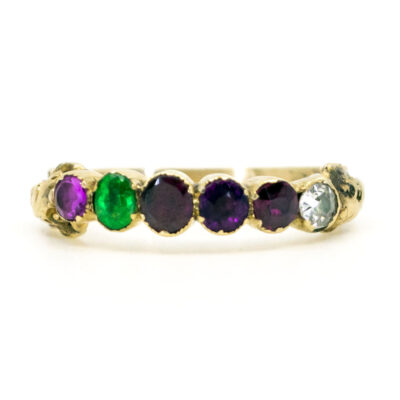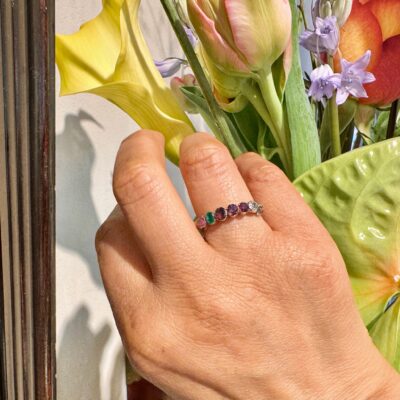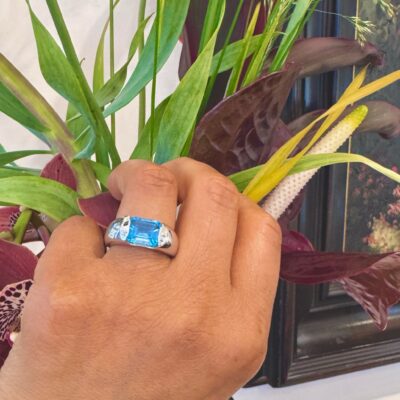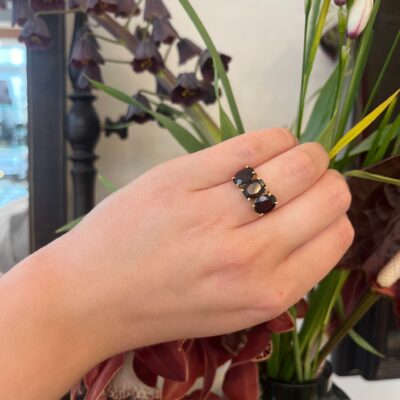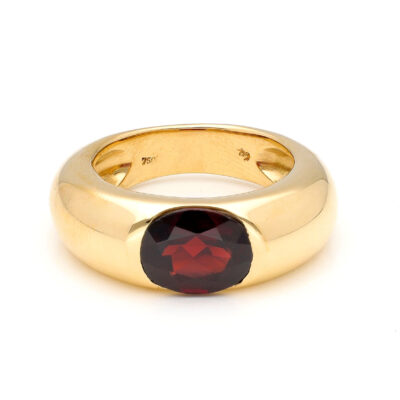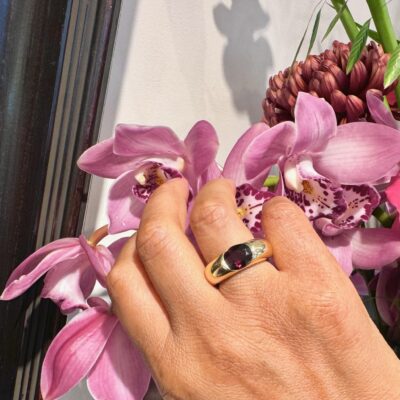A kaleidoscope of color in one elegant row: garnet, peridot, aquamarine, citrine, and amethyst sparkle side by side in this early 20th-century Harlequin ring. Set in warm 14k gold with delicate rose-cut diamond accents, it’s a joyful nod to the glamour of bygone eras. 🎨
Details: ±0.45ct Garnet, ±0.73ct Peridot, ±1.40ct Topaz, ±0.58ct Citrine, ±0.30ct amethyst, Rose-cut diamond, 14k Ring.
Design Era: Mid 20th Century (1950-1970).
Size: 18.25 NL / 57.0 FR / 8 US / P½ UK, sizeable (Within reason. Contact seller for information).
Weight in grams: 4.
Condition: Very good condition – slightly used with small signs of wear.
Harlequin jewellery, as the name suggests, draws its inspiration from the colourful patchwork costumes of the 16th Century “Commedia dell’arte” characters. The style became popular during the 19th Century and saw wonderful pieces of jewellery abundantly decorated in multi-coloured gemstones, making them both elegant and playful.
Shipping and Pickup: This remarkable piece ships from our store located in the center of Amsterdam, The Netherlands. We offer both registered shipping and local pickup at our store. In the case of local pickup, any applicable shipping costs will be refunded.
About Us: Add some sparkle to your style with Binenbaum.com. We offer a stunning selection of antique and vintage jewelry that you won’t find anywhere else. From timeless rings and dazzling necklaces to unique brooches, we have something for every taste and occasion. Visit our website today and treat yourself to a piece of history.
| Design Era | |
|---|---|
| Design & Historical Context | The 1950s were a time of great cultural and technological change, marked by the emergence of rock 'n' roll, the birth of the Beat Generation, the launch of Sputnik, and the beginning of the space race. These events, and the knowledge that the world was living in a nuclear age, contributed to the development of an aesthetic known as the Atomic Age, which was reflected in various aspects of design, including jewelry. |
| Key Materials | |
| Materials & Craftsmanship | Garnet: The Stone of Passion and Protection Garnet, renowned for its deep red hue, is a gemstone that symbolizes passion, energy, and protection. Though commonly associated with its rich red color, garnet actually comes in a variety of shades, including green, orange, and even rare blue, making it a versatile and intriguing gemstone. Garnet has a long history of use, dating back to ancient Egypt, where it was worn by pharaohs as a symbol of life and power. In Roman times, garnets were often set into signet rings used to stamp wax seals on important documents. The stone was also believed to offer protection to travelers and warriors, warding off harm and ensuring safe journeys. In jewelry, garnet’s durability, with a Mohs hardness of 6.5 to 7.5, and its striking color make it a popular choice for rings, necklaces, and earrings. Its ability to capture and reflect light with a warm, fiery glow adds a touch of drama and sophistication to any piece. Garnet is more than just a gemstone; it is a symbol of enduring passion and strength. Its vibrant energy and historical significance make it a timeless and powerful choice for jewelry that stands out and tells a story. Peridot: The Gem of Light and Renewal Peridot, with its vibrant green hue, is a gemstone that symbolizes light, renewal, and growth. This stunning gem is one of the few gemstones that occur in only one color, ranging from a yellowish-green to a deep olive, depending on the amount of iron within the crystal structure. Peridot is a type of olivine and is formed deep within the Earth’s mantle, often brought to the surface by volcanic activity. Historically, peridot has been revered for its protective qualities. The ancient Egyptians called it the gem of the sun, believing it could ward off evil spirits and bring the wearer happiness and peace. Peridot was also highly valued in ancient Rome, where it was worn as a talisman for protection and was thought to bring good fortune. In modern jewelry, peridot is celebrated for its fresh, lively color and its ability to brighten any design. With a Mohs hardness of 6.5 to 7, peridot is durable enough for everyday wear, making it a popular choice for rings, necklaces, and earrings. Its bright green color pairs beautifully with gold and silver, adding a touch of warmth and vibrancy to any piece. Peridot is more than just a gemstone; it is a symbol of positivity, renewal, and the enduring beauty of nature. Its radiant green hue and rich historical significance make it a joyful and elegant choice for jewelry that inspires and uplifts. Topaz: The Gem of Clarity and Strength Topaz, known for its brilliant clarity and wide range of colors, is a gemstone that symbolizes strength, healing, and abundance. While naturally colorless, topaz can be found in a variety of hues including golden yellow, blue, pink, and even rare red, with some colors resulting from natural processes and others enhanced by treatments. Historically, topaz has been associated with powerful metaphysical properties. In ancient Egypt, it was believed to be a gift from the sun god Ra, offering protection and healing. The name topaz is thought to derive from the Sanskrit word tapas, meaning fire, or from the ancient Greek island of Topazios, where the stone was first mined. In modern jewelry, topaz is valued for its brilliance and versatility. With a Mohs hardness of 8, topaz is durable enough for everyday wear, making it a popular choice for rings, pendants, earrings, and bracelets. Blue topaz, in particular, has become a favorite for its cool, calming color, often set in silver or white gold to enhance its sparkling clarity. Topaz is more than just a gemstone; it is a symbol of clarity, resilience, and positive energy. Whether chosen for its vibrant color or its deep symbolic meanings, topaz makes an elegant and meaningful choice for jewelry that is both beautiful and enduring. Citrine: The Gem of Joy and Abundance Citrine, with its warm, golden hues, is a gemstone that radiates positivity, joy, and abundance. This captivating gem is a variety of quartz, with colors ranging from pale yellow to deep amber, often reminiscent of the sun's warm glow. Its vibrant color comes from trace amounts of iron within the crystal structure. Historically, citrine has been treasured for its beauty and believed to carry the energy of the sun, bringing warmth, vitality, and happiness to those who wear it. In ancient times, citrine was known as the merchant’s stone, believed to attract wealth and prosperity. It was also used as a protective talisman against negative energies and was thought to inspire confidence and clarity in decision-making. In modern jewelry, citrine is cherished for its brilliance and affordability. With a Mohs hardness of 7, it is durable enough for everyday wear, making it a popular choice for rings, necklaces, earrings, and bracelets. Citrine's sunny disposition pairs well with both gold and silver, adding a touch of warmth and light to any jewelry design. Citrine is more than just a gemstone; it is a symbol of joy, success, and positive energy. Its radiant color and uplifting qualities make it a beloved choice for jewelry that celebrates life’s bright moments and encourages an optimistic outlook. amethyst: The Stone of Tranquility and Elegance Amethyst, a striking violet gemstone from the quartz family, is cherished for its vibrant hues, ranging from soft lavender to deep purple. Formed in volcanic rocks and geodes, its rich color comes from iron and trace elements, enhanced by natural radiation over millions of years. Historically, amethyst has been prized by many cultures. The ancient Greeks believed it could prevent intoxication, naming it amethystos, meaning not drunk. It was also a symbol of royalty and spirituality, often used in crowns and religious artifacts during the Middle Ages. In modern jewelry, amethyst’s durability (Mohs hardness of 7) and stunning color make it a popular choice for rings, necklaces, and other pieces. Known as the Stone of Tranquility, it is believed to calm the mind and enhance spiritual clarity. Amethyst is not just a beautiful gemstone; it carries a rich history and symbolism that adds depth to any piece of jewelry, making it a timeless and elegant choice. Rose-cut diamond: The Vintage Gem of Romance and Light Rose-cut diamonds are a beautiful and romantic choice in the world of jewelry, known for their distinctive dome-shaped appearance and soft, glowing sparkle. This antique diamond cut, dating back to the 16th century, features a flat bottom and a domed top covered in triangular facets that resemble the petals of a rosebud—hence the name. Historically, rose-cut diamonds were highly prized during the Georgian and Victorian eras, often used in jewelry pieces meant to be worn in candlelight, where their gentle sparkle added a warm, intimate glow. Unlike modern brilliant cuts, which are designed for maximum fire and brilliance, rose-cut diamonds offer a more subdued, yet enchanting, reflection of light. In modern jewelry, rose-cut diamonds are cherished for their vintage appeal and unique charm. Their flat base and shallow profile make them perfect for creating low-profile, elegant designs that sit close to the skin, such as in rings, pendants, and earrings. Rose-cut diamonds are often used in vintage-inspired and bespoke pieces, where their historical elegance adds a touch of timeless romance. Rose-cut diamonds are more than just a gemstone choice; they are a symbol of understated beauty and classic romance. Their soft, luminous sparkle and antique allure make them an ideal choice for jewelry that tells a story and captures the essence of a bygone era. 14k: The Durable Choice for Everyday Elegance 14k gold is a popular and practical choice in fine jewelry, known for its durability, affordability, and beautiful color. The 14k signifies that the gold is composed of 58.3% pure gold and 41.7% alloyed metals, such as copper, silver, nickel, or zinc. This combination results in a strong and resilient material that can withstand the rigors of daily wear, making it an ideal option for those seeking both beauty and durability. Historically, gold has always been a symbol of wealth and luxury, and 14k gold strikes a perfect balance between the rich appearance of gold and the strength needed for everyday use. Because of its lower gold content compared to 18k or 24k gold, 14k gold is more affordable, making it a popular choice for a wide range of jewelry pieces. In modern jewelry, 14k gold is appreciated for its versatility and variety. It is available in several colors, each achieved by mixing gold with different metals: Yellow Gold: A classic and timeless choice, 14k yellow gold has a warm, golden hue that complements most skin tones and is well-suited for both modern and traditional designs. White Gold: Created by alloying gold with white metals like nickel or palladium, 14k white gold has a sleek, silver-like appearance. It is often rhodium-plated for added shine and is a popular choice for engagement rings and other contemporary jewelry. Rose Gold: Achieved by mixing gold with copper, 14k rose gold has a soft, pinkish hue that has gained popularity for its romantic and vintage appeal. It is a favorite for those seeking a unique and stylish alternative to traditional gold colors. 14k gold is commonly used in a wide array of jewelry, including rings, necklaces, bracelets, earrings, and watches. Its durability makes it especially suitable for pieces that are worn daily, such as wedding bands and engagement rings, where the balance between strength and beauty is crucial. 14k gold is more than just a practical choice; it is a symbol of enduring style and everyday luxury. Its ability to retain the look of gold while offering greater resistance to scratches and dents makes 14k gold a versatile and timeless option for any jewelry collection. Whether in a simple band or an elaborate design, 14k gold offers a perfect blend of elegance and durability that can be enjoyed for years to come. |
| Size | |
| Gender | |
| Weight (in grams) | 4 |
| Condition | Very good condition – slightly used with small signs of wear |
By following these tips, you can enjoy your precious jewelry for many years to come.
Related Products
-
Amethyst Diamond Emerald Garnet Ruby Regard (Multi Gemstone) 10k Regard Ring 10806-6711
€ 1.895,00 VAT incl. (where applicable) -
Topaz 18k Ring 17420-9193
€ 2.895,00 VAT incl. (where applicable) -
Garnet 18k Trilogy Ring 17477-9204
€ 1.895,00 VAT incl. (where applicable) -
Garnet 18k Gypsy Ring 16736-8970
€ 3.895,00 VAT incl. (where applicable) -
Topaz Diamond 14k Square-Shape Ring 11365-0193
€ 1.395,00 VAT incl. (where applicable) -
Amethyst Diamond 14k Square-Shape Ring 13768-0246
€ 1.695,00 VAT incl. (where applicable) -
Citrine Diamond 18k Ring 16412-8843
€ 1.795,00 VAT incl. (where applicable) -
Diamond 14k Trilogy Ring 16902-9008
€ 1.695,00 VAT incl. (where applicable)
- Home
- Collection
- Fine Jewelry
- Silver Jewelry
- Silverware
- Boxes
- Candlesticks
- Salt and pepper shakers
- Miniatures
- Salt cellars
- Spoon Set
- Condiments
- Frames
- Napkin Ring
- Spoon
- Oddities
- Cups
- Vases
- Cutlery
- Serving Spoon And Cake Server
- Candlesticks
- Baskets
- Hanukkiah
- Spice Tower
- Yad
- Tea Set
- Sugar Castor
- Napkin Rings
- Wine Bottle Coaster
- Wine Stopper
- Tea Pot
- Jugs
- Rattles
- Hip Flask
- Miscellaneous
- Rings 💍
- About
- Contact






